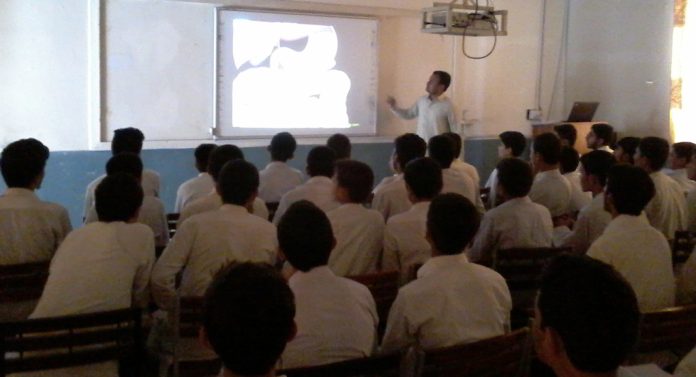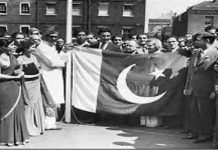Peshawar: The gloomy classroom is packed with dynamic students. Their eyes glitter as they look attentively towards moving sketches on a gleaming screen fixed on front wall of their classroom.
Students are completely heedful to a lesson being taught by their teacher through a newly introduced technology in government schools called ‘interactive whiteboards. They enjoy learning the lessons of a subject which is otherwise boring and complicated for most of them.
In this biology class of grade 10th in Government Cantt. No.1 School in Peshawar,
Shahid Yousafzai is one of the students who look excited learning through this new technology.
“I comprehend the complicated lessons much easily and effectively when our teachers elaborate through related illustrations and videos on the screen,” Shahid tells this scribe.
Interactive whiteboard is a new technology recently introduced by Elementary and Secondary Education Department in the school of Khyber Pakhtunkhwa to alter the traditional methods of teaching and learning, especially in the scientific subjects.
Like students, teachers are also praising this initiative of government. They say that teaching scientific subjects to a class with huge strength of students was otherwise a tough job but the new technology has made it easier to a great extent.
“Teaching this way is handy and convenient not only for us (teachers) but also for students to easily comprehend the lessons of scientific subjects as compared to the traditional method,” said a teacher at another school in Peshawar.
Sajad Khan, an official at E&SED concerned to the project, told Truth Tracker that the sole purpose of the introduction of this new technology was to revolutionize the obsolete methods of teaching in public sector schools.
He said that 100 interactive whiteboards in different schools in the province were installed and more than Rs 54 million have been spent on it. The cost includes interactive whiteboards, projectors, solar backup systems and installation charges.
Salah Uddin, another official told Truth Tracker that initially it was planned to install interactive whiteboards in all high and higher secondary schools throughout the province but then the department switched to a more latest one: “Smart Screens”. The installation of Smart Screens in more than 1200 schools throughout the province had been completed, he added.
“Smart Screen is similar to interactive whiteboard but the former is more advanced, easy to use, energy efficient and overall more feasible as compared to the latter one.”
He said that another 4.3 billion have been spent on installation of Smart Screens in each high and higher secondary schools throughout the province.
This project of interactive whiteboards and smart screens, which the officials at E&SED call a ‘digital revolution’, like the other projects of government, also seems to be hitting a snag.
Some teachers at schools say that while government was spending billions on provision of this latest technology, enough attention was not being paid towards making teachers able to properly utilize it for due purposes.
A teacher at City No. 1 School in Peshawar told Truth Tracker that teachers weren’t given proper training by the education department to learn the usage of interactive whiteboards and Smart Screens. Many teachers (mostly old ones) hesitate or have the lack of ability to use this new technology. They instead prefer the old manual method.
“These digital tools worth millions are of no use as many teachers are struggling to get acquainted with these new tools for they had never been exposed to such digital tools before,” another official at the school said.
He also said that there is no relevant technical person available in schools who could fix problem or error in the system, in case.
When asked regarding teachers’ training, Salah Uddin said that each and every teacher was given three-days training by relevant experts and many of them are now using it too. The prime reason, he said, for switching to Smart Screens, from interactive whiteboards was only that it was more easy to use for teachers,” said Salah Uddin.
He said most of teachers who aren’t using the technology are those aged ones who hesitate to use technology or those who are personally uncomfortable with this new way of teaching.




